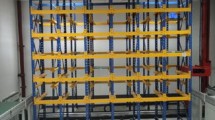Abstract
Internet of Things and artificial intelligence technology are the key elements of the intelligent construction of iron and steel production warehouse. This paper puts forward a whole set of intelligent scheme for bar warehouse crane for the guidance of metallurgical process engineering, including cluster rapid self-awareness technology of the smart crane, precise self-executing technique of crane with rigid-flexible hybrid structure, multi-body system kinematics model of the smart crane sling and the swing characteristics model at different azimuth, anti-swing control technology based on the optimization objective function, the vehicle model recognition system based on lidar, and the clustering crane dynamic scheduling method based on multi-agent reinforcement learning. The complete intelligent logistics system of the bar warehouse has changed the original operation mode of the warehouse area and realized the unmanned operation and intelligent scheduling of the crane, which is of great significance for improving the production efficiency, reducing the production cost, and improving the product quality.
Similar content being viewed by others
References
M. Chiang and T. Zhang, Fog and IoT: An overview of research opportunities, IEEE Internet Things J., 3(2016), No. 6, p. 854.
J.C. Liu, Y.H. Li, Y.Y. Lu, X.X. Fu, and S.L. Yan, Research on the influence factors of ubiquitous power Internet of Things for promoting consumption of wind power based on fuzzy G1-ISM in China, Int. J. Electr. Power Energy Syst., 121(2020), art. No. 106124.
S.H. Fang and T.N. Lin, Cooperative multi-radio localization in heterogeneous wireless networks, IEEE Trans. Wireless Commun., 9(2010), No. 5, p. 1547.
S.H. Fang and C.H. Wang, A novel fused positioning feature for handling heterogeneous hardware problem, IEEE Trans. Commun., 63(2015), No. 7, p. 2713.
R. Polikar, Ensemble learning, Scholarpedia, 4(2009), No. 1, art. No. 2776.
Z.M. Ding and X. Gao, A database cluster system framework for managing massive sensor sampling data in the Internet of Things, Chin. J. Comput., 35(2012), No. 6, p. 1175.
H. Kawai, S. Tanaka, Y. Choi, Y.-B. Kim, and Y. Kubota, Container crane system using an anti-sway controller with an image sensor, [in] Proceedings Volume 6794, ICMIT 2007: Mechatronics, MEMS, and Smart Materials, Gifu, 2007, art. No. 67944Z.
N.Đ. Zrnić, S.M. Bošnjak, and K. Hoffmann, Parameter sensitivity analysis of non-dimensional models of quayside container cranes, Math. Comput. Modell. Dyn. Syst., 16(2010), No. 2, p. 145.
M.H. Tong, Y.M. Wang, and H.Q. Qiu, Dynamic responses of high speed quay container cranes, Procedia Eng., 16(2011), p. 342.
Q.H. Ngo and K.S. Hong, Sliding-mode antisway control of an offshore container crane, IEEE/ASME Trans. Mechatron., 17(2012), No. 2, p. 201.
S.H. Ham, M.I. Roh, H. Lee, and S. Ha, Multibody dynamic analysis of a heavy load suspended by a floating crane with constraint-based wire rope, Ocean. Eng., 109(2015), p. 145.
L.F. Mei, Y.Q. Wang, and H.H. Lan, A new automatic recognition system of automobile type, Manuf. Autom., 28(2006), No. 12, p. 68.
Y.X. Zhang, D.Q. Fan, D. Yang, and C. Yang, Study on automatic vehicle recognition system, Traffic Transp., 7(2006), No. 1, p. 45.
Y. Yang, X.J. Luo, and L.L. Wang, The design and realization of automobile vehicle type image automatic diagnosis system based on nerve network, Microcomput. Appl., 31(2010), No. 2, p. 56.
Q. Hu, Research on automatic vehicle identification system based on laser radar, Transpoworld, 2017, No. 34, p. 10.
R.S. Sutton and A.G. Barto, Introduction to Reinforcement Learning, MIT Press, Cambridge, 1998.
P. Henderson, R. Islam, P. Bachman, J. Pineau, D. Precup, and D. Meger, Deep reinforcement learning that matters, [in] Thirty-Second AAAI Conference on Artificial Intelligence, New Orleans, Louisiana, 2018, p. 3207.
P. Sunehag, G. Lever, A. Gruslys, W.M. Czarnecki, V. Zambaldi, M. Jaderberg, M. Lanctot, N. Sonnerat, J.Z. Leibo, K. Tuyls, and T. Graepel, Value-decomposition networks for cooperative multi-agent learning based on team reward, [in] Proceedings of the 17th International Conference on Autonomous Agents and MultiAgent Systems, Stockholm, 2018, p. 2085.
R. Lowe, Y. Wu, A. Tamar, J. Harb, P. Abbeel, and I. Mordatch, Multi-agent actor-critic for mixed cooperative-competitive environments, [in] Proceedings of the 31st Conference on Neural Information Processing Systems, Long Beach, CA, 2017, p. 6382.
M. Hausknecht and P. Stone, Deep recurrent Q-learning for partially observable MDPs, [in] AAAI Fall Symposium on Sequential Decision Making for Intelligent Agents, Arlington, Virginia, 2015.
Z.W. Hong, S.Y. Su, T.Y. Shann, Y.H. Chang, and C.Y. Lee, A deep policy inference Q-network for multi-agent systems, [in] Proceedings of the 17th International Conference on Autonomous Agents and MultiAgent Systems, Stockholm, 2018, p. 1388.
Acknowledgements
This work was financially supported by the National Key Research and Development Plan of China (No. 2020YFB1713600), the National Natural Science Foundation of China (No. 51975043), and the Fundamental Research Funds for the Central Universities (Nos. FRF-TP-19-002A3 and FRF-TP-20-105A1).
Author information
Authors and Affiliations
Corresponding author
Rights and permissions
About this article
Cite this article
He, Hn., Wang, Xc., Peng, Gz. et al. Intelligent logistics system of steel bar warehouse based on ubiquitous information. Int J Miner Metall Mater 28, 1367–1377 (2021). https://doi.org/10.1007/s12613-021-2325-z
Received:
Revised:
Accepted:
Published:
Issue Date:
DOI: https://doi.org/10.1007/s12613-021-2325-z




